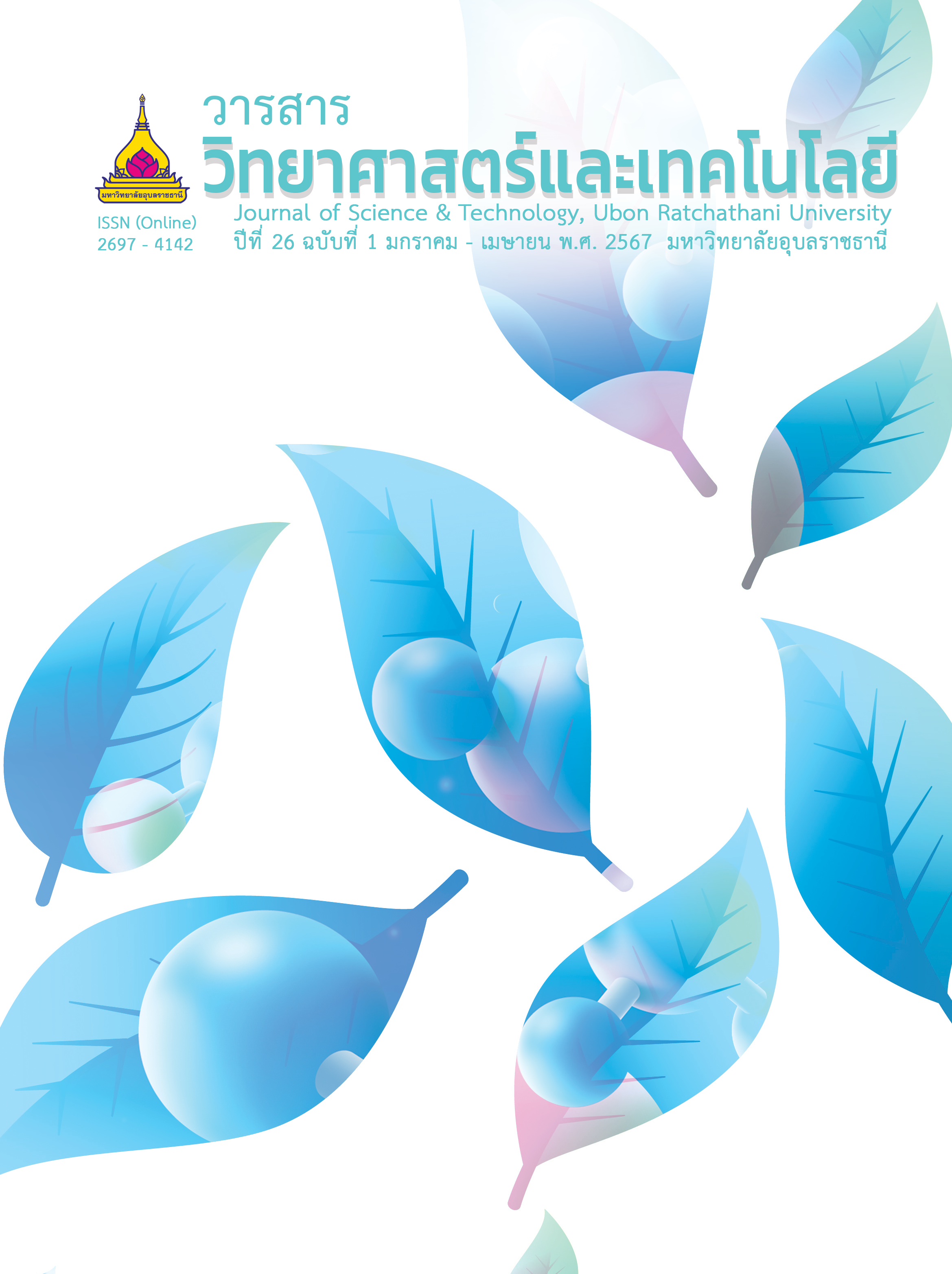การศึกษาประสิทธิภาพของการดูดซับน้ำมันและไขมันของวัสดุดูดซับที่ได้จากของเหลือทิ้งทางการเกษตร และการผลิตเชื้อเพลิงอัดแท่งจากวัสดุดูดซับที่มีประสิทธิภาพสูง
Main Article Content
บทคัดย่อ
งานวิจัยนี้มีวัตถุประสงค์เพื่อศึกษาผลของค่าความเป็นกรด-ด่าง และปริมาณของน้ำเสียสังเคราะห์ต่อประสิทธิภาพการดูดซับน้ำมันและไขมันของวัสดุดูดซับที่เตรียมจากใยตาล ใบหอมแดง และใยไผ่ รวมทั้งเพื่อศึกษาความเป็นไปได้ในการผลิตเชื้อเพลิงอัดแท่งจากตัวดูดซับที่มีประสิทธิภาพการดูดซับน้ำมันและไขมันที่ดีที่สุด ผลการศึกษาพบว่าตัวดูดซับที่เตรียมได้จากใยตาลให้ประสิทธิภาพในการดูดซับน้ำมันและไขมัน และประสิทธิภาพการกรองของแข็งแขวนลอยได้มากที่สุดเมื่อน้ำเสียมีปริมาตร 3 ลิตร และมีค่าความเป็นกรด-ด่างเท่ากับ 8 ดังนั้นจึงนำตัวดูดซับดังกล่าวไปผลิตเป็นเชื้อเพลิงอัดแท่ง จากการศึกษาพบว่าอัตราส่วนของถ่านไม้ต่อใยตาลที่ 50:50, 40:60 และ 30:70 เป็นอัตราส่วนที่เหมาะสมสำหรับผลิตเชื้อเพลิงอัดแท่ง เนื่องจากอัตราส่วนดังกล่าวทำให้เชื้อเพลิงอัดแท่งขึ้นรูปได้ดี และมีค่าพลังงานความร้อนสูงถึง 7,054, 7,299 และ 6,954 แคลอรี่ต่อกรัม ตามลำดับ นอกจากนี้ เชื้อเพลิงอัดแท่งหล่านี้ยังมี ค่าพลังงานความร้อน และค่าความชื้นผ่านเกณฑ์มาตรฐานผลิตภัณฑ์ชุมชนถ่านอัดแท่ง ดังนั้นใยตาลจึงสามารถใช้เป็นวัสดุดูดซับน้ำมันและไขมันจากน้ำทิ้ง และเป็นวัสดุในการผลิตเชื้อเพลิงอัดแท่งสำหรับใช้ในครัวเรือนเพื่อลดการใช้ถ่านไม้
Article Details

อนุญาตภายใต้เงื่อนไข Creative Commons Attribution-NonCommercial-NoDerivatives 4.0 International License.
บทความที่ได้รับการตีพิมพ์เป็นลิขสิทธิ์ของ วารสารวิทยาศาสตร์และเทคโนโลยี มหาวิทยาลัยอุบลราชธานี
ข้อความที่ปรากฏในบทความแต่ละเรื่องในวารสารวิชาการเล่มนี้เป็นความคิดเห็นส่วนตัวของผู้เขียนแต่ละท่านไม่เกี่ยวข้องกับมหาวิทยาลัยอุบลราชธานี และคณาจารย์ท่านอื่นๆในมหาวิทยาลัยฯ แต่อย่างใด ความรับผิดชอบองค์ประกอบทั้งหมดของบทความแต่ละเรื่องเป็นของผู้เขียนแต่ละท่าน หากมีความผิดพลาดใดๆ ผู้เขียนแต่ละท่านจะรับผิดชอบบทความของตนเองแต่ผู้เดียว
เอกสารอ้างอิง
Chalermwat, M. and Saripan, K. 2020. Effects of pH and wastewater loading on fat oil and grease adsorption efficiency by cattail flower, sugar cane bagasse and water hyacinth. Thai Science and Technology Journal. 28(1): 1965-1976. (in Thai)
Siriananphaiboon, S. 2020. Domestic wastewater. Vocational Education Central Region Journal. 4(1): 1-10. (in Thai)
Donchuprai, S. and et al. 2023. Comparison of oil adsorption capacity and efficiency corn husk and bamboo sheath. Science and Technology Nakhon Sawan Rajabhat University Journal. 15(21): 137-148. (in Thai)
Sriwongchai, S. 2017. Biodiesel Production from Agricultural Wastes by Using Biotechnological Process. SaKaeo: Faculty of Science and Social Science, Burapha University (Sakaeo Campus). (in Thai)
Abdul Hamid, N.S. and et al. 2016. Removal of oil and grease from wastewater using natural adsorbents. Jurnal Teknologi (Sciences and Engineering). 78: 97-102.
Marzuki, N.A. and Daud, N.H. 2018. Effect of durian husk and palm fiber on performance of “Dukoffilt” to treat domestic wastewater. Modern Environmental Science and Engineering. 4(2): 169-196.
Hendrasarie, N. and Maria, S.H. 2021. Combining grease trap and Moringa Oleifera as adsorbent to treat wastewater restaurant. South African Journal of Chemical Engineering. 37: 196-205.
Daud, Z. and et al. 2017. Feasibility of banana (Musa sapientum) trunk biofibres for treating kitchen wastewater. Nature Environment and Pollution Technology. 16(4): 1205-1210.
Wahi, R. and et al. 2013. Oil removal from aqueous state by natural fibrous sorbent: An overview. Separation and Purification Technology. 113: 51-63.
Wisetrat, O. and et al. 2012. Adsorption of suspended oil using bagasse and modified bagasse. Journal of Science and Technology Mahasarakham University. 31(4): 354-362. (in Thai)
Saripan, K. 2019. The adsorption of oil by agricultural waste and the briquette production from adsorbent. Journal of Renewable Energy for Community. 2(1): 10-16. (in Thai)
Rattanapanya, P. 2022. Feasibility Study to Invest in Renewable Energy from Biomass Sustainable Forest Products. M.Eng. Thesis, Silpakorn University. (in Thai)
Saema, C. and Thongboonrith, K. 2016. The study on efficacy charcoal from corncob and charcoal from cassava rhizome. In: Proceedings of the 3rd Kamphaeng Phet Rajabhat University Annual Conference, 22 December 2016. Kamphaeng Phet, Thailand. (in Thai)
Pukdee-asa, M. and Pimpan, P. 2022. Fuel briquettes from waste of lemon grass and banana peel. Science and Technology Nakhon Sawan Rajabhat University Journal. 14(19): 107-121. (in Thai)
Anantanukulwong, R., Chemae, R. and Sareanu, N. 2019. Production of charcoal from agricultural residues. YRU Journal of Science and Technology. 4(1): 47-53. (in Thai)
Sittisart, P. and et al. 2022. Energy potential of charcoal briquette from flamboyant and black rosewood pods. Journal of Science & Science Education. 5(2): 202-214. (in Thai)
The Botanical Garden Organization. 2013. Medicinal Plants Database. http://www.qsbg. org/database/plantdb/mdp/medicinal-specimen. asp?id=492. Accessed 20 February 2023. (in Thai)
Yantaboot, K. and Kaewarsa, P. 2020. Physical properties of natural rubber foam reinforced with Borassus fruit fiber: Effects of alkali treatment and fiber content. Journal of Science and Technology, Ubon Ratchathani University. 22(3): 75-81. (in Thai)
Thirach, P. 2013. Effect of Cu2+ and Humic Acid on Cell Division of Allium ascalonicum Linn. Root Tips. M.Sc. Thesis, Silpakorn University. (in Thai)
Kaewmorrakot, T. 2014. Production of Compost from Shallot Waste, Bone Meal and Goat Dung. M.Sc. Thesis, Prince of Songkla University. (in Thai)
Kavitha, S. and et al. 2022. An insight - A statistical investigation of consolidated bioprocessing of Allium ascalonicum leaves to ethanol using Hangateiclostridium thermocellum KSMK1203 and synthetic consortium. Renewable Energy. 187: 403-416.
Bunnag, S. 2020. A Study on Physical and Chemical Properties of Bamboo through Torrefaction Process. M.Sc. Thesis, Thammasat University. (in Thai)
Kaewkhunjit, S. 2018. Application of Clean Technology for Wastewater Treatment in Housing Estate. M.Sc. Thesis, National Institute of Development Administration. (in Thai)
American Society for Testing and Materials (ASTM). 2019. Standard Test Method for Gross Calorific Value of Coal and Coke. https://www.astm.org/d5865-13.html. Accessed 15 December 2021.
Chumsang, C. and Upan, P. 2013. Creation of Added Value of Waste Material from Palmyra Palm. Technology Transfer Project Report, Uttaradit Rajabhat University. (in Thai)
Lim, T.T. and Huang, X. 2006. In situ oil/water separation using hydrophobic-oleophilic fibrous wall: A lab-scale feasibility study for groundwater cleanup. Journal of Hazardous Materials. 137(2): 830-826.
Srimoon, R. 2016. Dyes treatment in wastewater using adsorption processes. KKU Science Journal. 44(3): 419-434. (in Thai)
Thai Industrial Standards Institute. 2004. Community Product Standards of Charcoal Briquettes 238/2004. http://tcps.tisi.go.th/ public/StandardList.aspx. Accessed 15 December 2021. (in Thai)
Phutteesakul, R. 2010. The Production of Charcoal Briquette by Coconut Shell and Cassava Rhizome. M.Sc. Thesis, Srinakharinwirot University. (in Thai)
Jutajan, W. 2019. A study of charcoal burning process and properties of briquetted charcoal from vetiver grass. Journal of Industrial Technology Ubon Ratchathani Rajabhat University. 9(2): 135-146. (in Thai)
Tanpaiboonkul, N. and Budnumpetch, T. 2016. Molding and binding method on properties of fuel from water hyacinth. Veridian E Journal Science and Technology, Silpakorn University. 2(1): 10-16. (in Thai)


